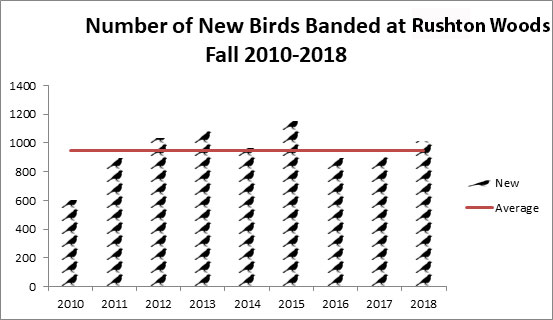At Rushton we do as the birds do and follow their seasons. Each season is unique in its own way, so when we look at the data, we look at each season independently.
This fall we seem to be catching more birds than we have in the past. This does not contradict the recent reports of bird declines, it simply shows that during this small window of bird migration, over the short time span of 10 years, this is the most we have captured. It’s too soon to know why there are more birds this year; maybe the habitat is just right this year. We changed the habitat slightly by increasing the shrub scrub due to a slightly altered mowing regime. We have also been able to band a little more this fall than in previous years, due to favorable weather. It could also be that we happen to be catching good migration weather, the best winds and on the right days. We have a set schedule of banding the same three days each week, but the birds travel when the weather is right, no matter what day!
A summary of 9 years of fall migration banding at Rushton:
We typically band from the last week in August until the first week in November, three days a week when conditions allow.
This year on October 10th we caught and banded our 1000th bird (a Black-throated Blue Warbler), at about halfway through the season, already surpassing our average total over the last nine years. Noting this great year, we hope this can become a tradition!
Our lowest year is likely due to fewer hours spent catching birds, more fairly, our lowest catch has been 893 birds and our highest in the last nine years was 1082 birds in 2013.
Looking forward, our winter residents and second most common bird of the fall season, the White-throated Sparrow, has yet to arrive, along with our tiniest fall migrant, the Ruby-crowned Kinglet, which combined, average another 200-300 birds, we can only begin to speculate how many birds we will total by November!
Table 1. Number of birds captured per year during fall migration.



